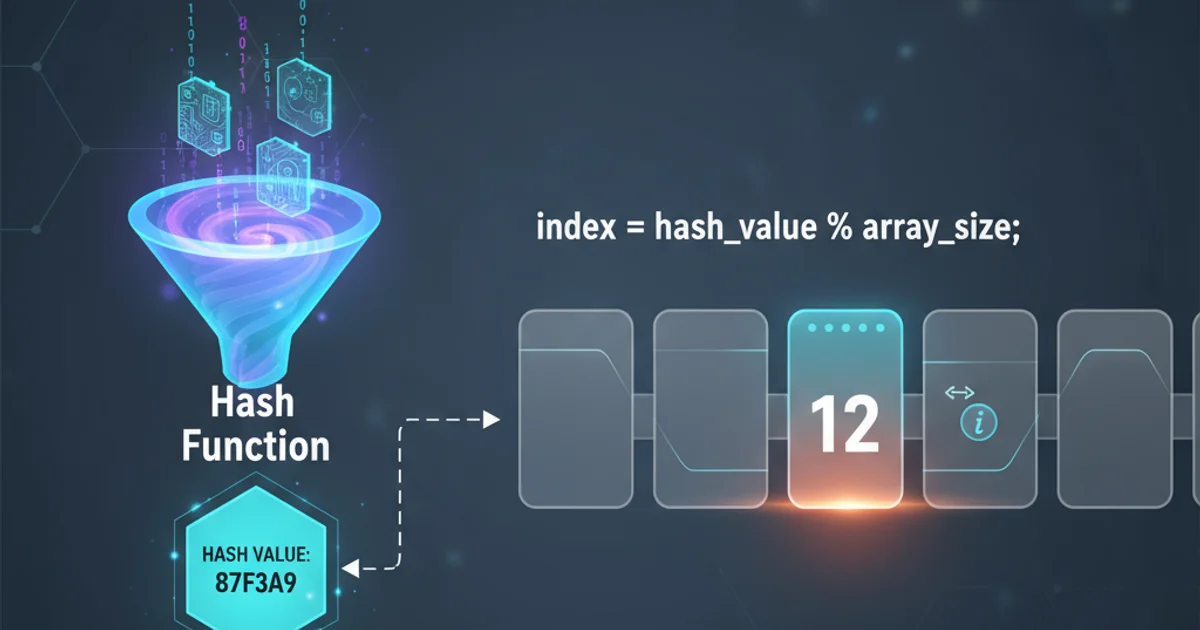Hash-table - Mapping a hash value to an index
Categories:
Mapping Hash Values to Array Indices in Hash Tables

Explore the fundamental techniques for converting a hash value into a valid array index, a critical step in hash table implementation for efficient data storage and retrieval.
Hash tables, also known as hash maps, are powerful data structures that provide average O(1) time complexity for insertions, deletions, and lookups. This efficiency stems from their ability to directly map keys to array indices. However, the raw hash value generated by a hash function often exceeds the bounds of the underlying array. This article delves into the essential methods for transforming a potentially large hash value into a valid, usable index within the hash table's array.
The Modulo Operator: The Primary Mapping Technique
The most common and straightforward method for mapping a hash value to an array index is using the modulo operator (%). This operator returns the remainder of a division, effectively constraining any integer to a range between 0 and N-1, where N is the divisor. In the context of hash tables, N is typically the size of the underlying array.
public int getIndex(int hashCode, int arraySize) {
return hashCode % arraySize;
}
Basic modulo operation for index mapping in Java
While simple, this method has a crucial consideration: hash codes can be negative in some programming languages (e.g., Java's hashCode() for String can return negative values). A negative hash code would result in a negative index, which is invalid. To address this, an additional step is required to ensure the index is always non-negative.
(hashCode & 0x7FFFFFFF) % arraySize in Java, which effectively clears the sign bit, or simply (hashCode % arraySize + arraySize) % arraySize for a more general solution.Handling Negative Hash Codes
As mentioned, negative hash codes can lead to invalid array access. There are several ways to convert a potentially negative hash code into a non-negative one before applying the modulo operator. The goal is to preserve the distribution properties of the hash function as much as possible.
public int GetIndex(int hashCode, int arraySize)
{
// Method 1: Using Math.Abs (can be problematic if hashCode is int.MinValue)
// return Math.Abs(hashCode) % arraySize;
// Method 2: Adding arraySize and then modulo (ensures positive result)
return (hashCode % arraySize + arraySize) % arraySize;
// Method 3: Bitwise AND with 0x7FFFFFFF (clears sign bit, common in Java)
// return (hashCode & 0x7FFFFFFF) % arraySize;
}
Different strategies for handling negative hash codes in C#
flowchart TD
A[Generate Hash Code] --> B{Is Hash Code Negative?}
B -- Yes --> C[Convert to Non-Negative]
B -- No --> D[Apply Modulo Operator]
C --> D
D --> E[Resulting Array Index]Flowchart for mapping a hash value to an array index, including negative hash code handling
Choosing the Array Size (Capacity)
The choice of arraySize (or capacity) significantly impacts the performance of a hash table. It's generally recommended to use a prime number for the array size when using the modulo operator. This helps in distributing hash values more evenly across the array, reducing collisions. If the array size is a power of two, the modulo operation hashCode % arraySize is equivalent to hashCode & (arraySize - 1). While this bitwise operation can be faster, it can also lead to more collisions if the hash function doesn't produce a wide range of bits, as it only considers the lower bits of the hash code.
Understanding how hash values are mapped to array indices is fundamental to implementing efficient hash tables. By correctly handling negative hash codes and choosing an appropriate array size, developers can build robust and performant data structures.